There are two locks in the starting fifteen players on a rugby team. They wear the four or five jersey and are the tallest players on the pitch.
Locks are also called “second rows”, and we’ll explain why in this article.
This article describes the role of a lock in rugby.
Why Are Locks Called Locks?
Locks get their name from their position in the scrum. They pack down in the second row, in front of the flankers and behind the props.
This diagram highlights the locks in scrum formation. They are numbered four and five.
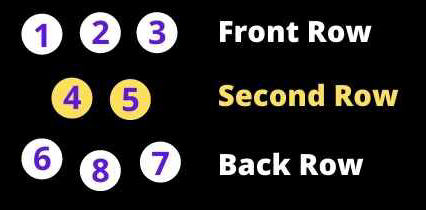
The role of locks in scrums is to bind to each other and the front row players ahead of them.
When both players in the second bind together, they lock the scrum into a stable and steady position. This is why they are called locks.
Other names for locks
They are also called second rowers for obvious reasons. Perhaps less obviously, you’ll hear old-timers refer to them as just “the row”.
But aren’t there three rows in a scrum? Yes, but these old-timers probably played in the second row. Of course, they think that only the middle row counts!
Locks In The Lineout
There’s a reason why locks are the tallest players in a rugby team. Their specialist role is to catch the ball in the lineout.
The opposition team will usually compete to catch the ball in the lineout. This is why locks are so tall – so they can reach higher than the opposition.
We have a separate article on the average heights of rugby players by position. I’ll mention here that the average in professional rugby in Europe is 6 foot 6. That’s three inches taller than the next position (flankers).
Of course, locks aren’t the only players who can jump to catch the ball. Teams often use flankers too. We discuss this in our article on the role of flankers.
Jumping in the lineout
This picture shows a training session with players lifting a lock. The arrows show the padding that locks wear to help their lifters.
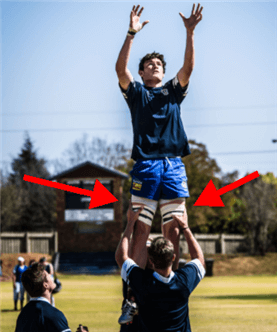
Before 1999, players weren’t allowed to be lifted by teammates in the lineout. They had to jump unaided but could be supported on the way down.
Of course, there was always a bit of skullduggery where teams “hid” how they were illegally lifting the jumpers. It became so endemic that the rugby authorities simply changed the laws to allow it.
So, you can understand why historically teams would always pick the tallest players to be locks.
But taller players are also heavier. A lighter flanker can be flung up into the air with ease! Why do we still need tall locks?
Well, lineouts have become hugely important in launching attacks for scoring opportunities. Going back to the 2015 World Cup, over half of the tries started with a lineout.
Teams usually want three good lineout options on their own throw. That’s two tall locks and a flanker.
Calling the lineout
Who decides whether the hooker throws short to the second player in the lineout or long to the tail?
The latter is more risky but that depends on how good the opposition jumpers are.
The choice will also determine the attacking moves. The person who decides the tactics at each lineout has a huge amount of responsibility.
You may think that the captain makes the decision. But the captain may be the outhalf or a prop – a player who has specialist knowledge in other areas.
The lineout caller is always one of the locks, and often the more experienced player.
At international level, both locks may be the lineout callers for their club team. It’s always interesting to figure out which has been chosen for the role between the two.
Defending the lineout
Locks can be potent weapons in stealing the ball on opposition throws.
This doesn’t just require an athletic leap and a long reach. The thief has been able to anticipate where the hooker is throwing the ball.
International-level locks spend hours studying the lineouts of opposing teams.
What Do Locks Do In Scrums?
You may hear commentators referring to the “tight five”. These are the players numbered one to five i.e. the front row and the two locks.
We’ve already shown a neat diagram of the scrum positions. But take a look at a real-life overhead still. You can see how closely bound the tight five are.
The flankers have pushed out and up so far that they are almost in the second row. But they are not providing the same kind of pushing power as the locks.
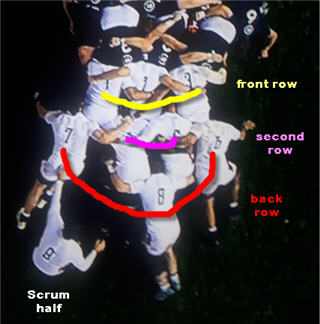
How do you bind as a lock?
The laws of rugby say that every forward in the scrum must be “bound”. This means they are in contact with the other players.
The locks crouch down side-by-side with their inner arms tightly bound around each other’s backs.
They push their heads between the outside thighs of the front row. Ever wonder why rugby players tape their ears? This is why locks do so.
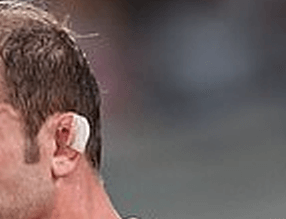
Do locks push in the scrum?
Locks are a key part to applying pressure in the scrum. Their role is both to keep the scrum steady and to drive the front row forward.
The two flankers have a different role in the scrum (we cover this in our article on flankers). The defending flankers in particular are often more lightly bound.
A good strong drive from the attacking team’s second row can drive the defending scrum backward.
Differences Between The 4 And 5 Lock Positions
One lock wears the four jersey and the other lock wears five. But is there any difference in their roles?
The difference is less pronounced than for blindside and openside flankers (numbers 6 and 7). And at lower levels, there often isn’t much difference at all.
But at elite levels, we refer to the tighthead and loosehead lock. This refers to which prop they bind to in the scrum.
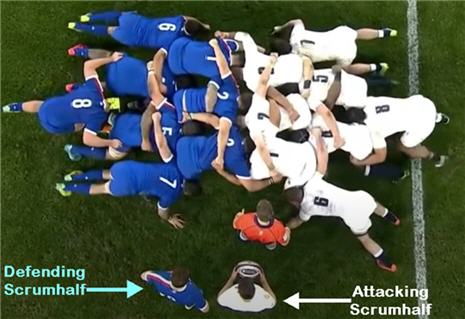
The number 5 is bound to the tighthead prop (number 3). The tighthead prop takes much of the pressure from the opposition and needs the most support.
This means that the larger heavier lock plays at 5.
The lighter skinnier lock plays at 4. If the two locks are of similar size and weight, then the younger or more mobile one is usually at 4.
Role of the number 5
When the number 5 is large as well as tall, they can be very effective in big hits and dominant tackles.
They are often seen as “enforcers” and are feared by opposition supporters (if not the opposition).
They also use their bulk to make carries. They may not make big yards, but the goal is to tie up several defenders in an effort to stop them.
Some locks are so heavy that they are difficult to lift in the lineout. They usually act instead as lifters.
This can put a team at a disadvantage with fewer lineout options. But the coach will probably pick two flankers who are known to be effective lineout jumpers.
Role of the number 4
The number 4 is usually lighter and more dynamic around the field. They will take part of the role of an openside flanker by following the rucks and running in support of linebreaks.
They will also put their height and reach to good use at the breakdown. Some locks are very effective at using those long levers to pilfer opposition ball.
You’ll also see a scrumhalf looking wary as the opposition lock looms overhead, ready to block down a kick.
If you’re not sure what goes on at the breakdown, check out our beginner article on rucking in rugby.
Who Are The Legends Of The Game?
It was a hard job to pick the greatest locks in rugby, but we narrowed down a short list of legends.
Do you agree with our choices? Check out the link where we explain every pick.